P-11: First on the battlefield and at sea (part of 1)
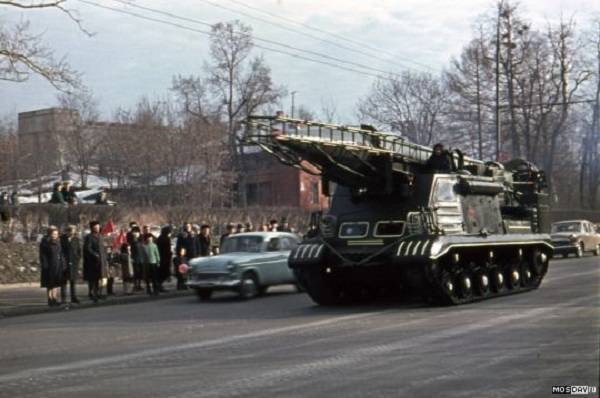
The R-11M self-propelled rocket launcher is heading for the November parade in Moscow. Photos from http://militaryrussia.ru
The Soviet missile systems, known in the West as Scud, that is, “Squall,” became one of the symbols of the USSR’s military-technical cooperation with the Arab countries of the Middle East - and the achievements of Soviet military missile engineering as a whole. Even today, half a century later, after the first such installations began to fall on the shores of the Red Sea, their characteristic silhouette and combat capabilities serve as an excellent characteristic of the skills and capabilities of Soviet rocket engineers and creators of mobile tactical missile systems. The Scuds and their heirs, already created by the hands of not Soviet, but Chinese, Iranian and other engineers and workers, flaunt at parades and participate in local conflicts - of course, with ordinary, fortunately, not “special” warheads.
Today, the name "Scud" means a very specific family of operational-tactical missile systems - 9K72 "Elbrus". It is part of its rocket P-17, which made famous this nickname. But in reality, for the first time, it was not she who received this formidable name, but her predecessor, the operational-tactical missile P-11, which became the first such serial missile in the Soviet Union. Her first test flight took place on 18 on April 1953 of the year, and although it was not very successful, it was from him that story flights of this rocket. And it was she who was first assigned the Scud index, and all other complexes with this name became her heirs: P-17 grew from the last attempt to upgrade P-11 to P-11.
But not only "Scadam" paved the way for the famous "eleventh". The same rocket opened the era of Soviet missile submarines. Adapted for naval needs, she received the R-11FM index and became weapons The first Soviet missile-carrying submarines of the project 611AV and 629. But the original idea of developing the P-11 was not so much the creation of an operational-tactical missile, but rather an attempt on a real rocket to understand whether it is possible to create a combat missile on long-lasting fuel components ...
From V-2 to P-5
The first Soviet missile systems based on the P-1 and P-2 missiles were actually experimental. They were developed, taking as a basis - or, according to many participants of those works, virtually completely repeating - the German A4 rocket, aka the V-2. And it was a natural step: in the prewar and wartime German rocket engineers seriously overtook their colleagues both in the USSR and in the USA, and it would be foolish not to use the fruits of their work to create their own missiles. But before using, you need to understand exactly how they are arranged and why that is - and this is easier and best done by first trying to reproduce the original using your own technologies, materials and technical capabilities.
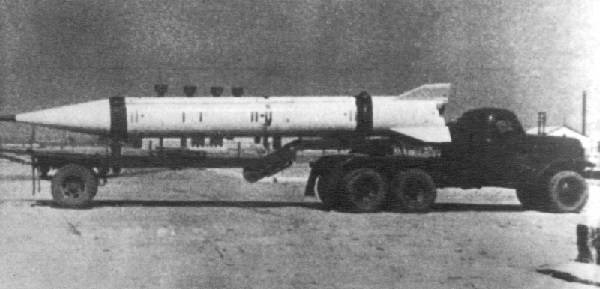
One of the first production missiles P-11 on the conveyor. Photos from http://militaryrussia.ru
The intensity of the work at the first stage of creating a national nuclear missile shield can be judged from the data cited by Academician Boris Chertok in his book “Missiles and People”: “The full-scale work on the first Russian missile R-1 began in 1948 year. And in the autumn of this year, the first series of these missiles passed flight tests. In the 1949 – 1950, flight tests of the second and third series took place, and in 1950, the first domestic missile system with the P-1 rocket was adopted. The launch mass of the P-1 rocket was 13,4 t, the flight range was 270 km, the equipment was a conventional explosive with a mass of 785 kg. The P-1 rocket engine copied the A-4 engine exactly. From the first domestic rocket required accuracy hit the rectangle 20 km in range and 8 km in the lateral direction.
A year after adopting the P-1 missile, the flight tests of the P-2 missile complex ended and it was adopted with the following data: launch weight 20 000 kg, maximum range 600 km, combat charge weight 1008 kg. The P-2 missile was supplied with radio correction to improve lateral accuracy. Therefore, despite the increase in range, the accuracy was no worse than that of the P-1. The rocket engine P-2 was increased by boosting the engine P-1. In addition to the range, the essential difference between the P-2 and the P-1 was the implementation of the idea of separating the head section, the introduction of the carrying tank into the hull design and the transfer of the instrument compartment to the lower part of the hull.
In the 1955, tests ended and the P-5 missile system was adopted. The launch weight is 29 t, the maximum range is 1200 km, the combat charge weight is about 1000 kg, but there could be two or four more outboard combat units when launched on 600 – 820 km. The accuracy of the missile was enhanced by the use of a combined (autonomous and radio) control system.
A substantial modernization of the P-5 missile system was the P-5M complex. The R-5M missile was the first military equipment rocket in the history of the world to carry a nuclear charge. The P-5M rocket had a launch mass of 28,6 and a range of 1200 km. The accuracy is the same as that of the P-5.
The P-1, P-2, P-5 and P-5M missiles were single-stage, liquid, the components of the fuel were liquid oxygen and ethyl alcohol. "
Oxygen missiles became a real fad of the general designer Sergey Korolev and his team from OKB-1. It was on the 4 oxygen rocket of October 1957 of the year that the first artificial satellite of the Earth was put into space, and on the P-7 oxygen rocket, the legendary seven, was poisoned on the 12 flight of April 1961 of the Earth’s first cosmonaut Yuri Gagarin. But oxygen, alas, imposed significant restrictions on rocket technology if it was a question of using it as a carrier of nuclear weapons.
And if you try nitric acid? ..
Even the best of Sergey Korolev’s oxygen intercontinental ballistic missiles — the famous P-9 — was tied to a complex system of maintaining sufficient oxygen levels in the fuel system (for more details on this rocket, see "P-9: hopelessly late excellence"). But the "nine" was created much later, and never became a truly massive ICBM of the Soviet Missile Forces - and precisely because of the difficulties in ensuring the long-term combat duty of the system, flying on oxygen.
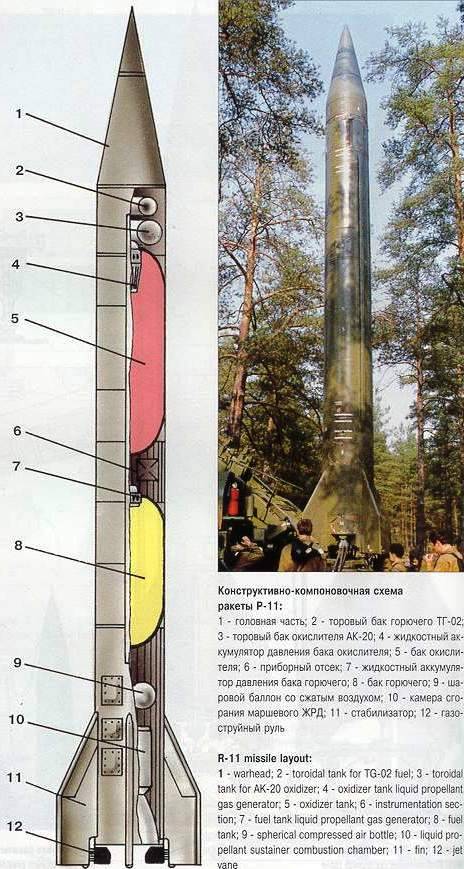
The layout of the rocket P-11. Photos from http://svirv.narod.ru
The designers, and especially the military, who began to operate the first domestic missile systems in experimental mode, quickly understood what these difficulties were. Liquid oxygen has an extremely low boiling point - minus 182 degrees Celsius, and therefore it evaporates extremely actively, leaking from any untight compound of the fuel system. The footage of the space newsreel clearly shows how the rockets "emit steam" on the launching tables of Baikonur - this is precisely the result of the evaporation of oxygen used in such rockets as an oxidizer. And since there is constant evaporation, it means that constant refueling is necessary. But it is impossible to provide it in the same way as refueling a car with gas from a pre-stored canister - all because of the same evaporation losses. And in fact, the starting complexes of oxygen ballistic missiles are tied to oxygen-producing plants: this is the only way to ensure a constant replenishment of the stock of the oxidizing component of rocket fuel.
Another significant problem of the first domestic oxygen war rockets was the system of their launching process. The main component of rocket fuel was alcohol, which, when mixed with liquid oxygen, does not ignite on its own. To launch a rocket engine, you need to enter into it a special pyrotechnic incendiary device, which at first was a wooden structure with a magnesium tape, and later became a liquid, but even more complex structure. But in any case, it worked only after the fuel component supply valves were opened, and accordingly, its losses were again noticeable.
Of course, over time, most likely, all these problems could be solved or, as happened with non-military missile launches, ignored. However, for the military, such design flaws were critical. This was especially true of missiles that were supposed to receive maximum mobility - operational tactical, tactical and ballistic short and medium range. After all, their advantages should be ensured the possibility of transfer to any region of the country, which made them unpredictable for the enemy and made it possible to deliver a sudden blow. And to carry behind each such missile battalion, figuratively speaking, our own oxygen plant - it was somehow too ...
Where promising the use of high-boiling fuel components for ballistic missiles: special kerosene and an oxidizer based on nitric acid, promised great promise. The study of the possibilities of creating such missiles was precisely the topic of a separate research work with the H-2 cipher, which from 1950 was conducted by the OKB-1 staff under the guidance of Sergey Korolev, who was part of the “rocket” research institute-88. The result of this R & D was the conclusion that rockets on high-boiling fuel components can only be of short and medium range, since for them it’s impossible to create an engine with sufficient firing, sustainably operating on such fuel. In addition, the researchers concluded that the fuel on high-boiling components generally does not have sufficient energy performance, and intercontinental ballistic missiles need to be built only on liquid oxygen.
Time, as we now know, refuted these findings through the efforts of designers led by Mikhail Yangel (who, incidentally, along with Sergei Korolev was the chief designer of P-11), who was able to build his intercontinental rockets on high-boiling components. But then, at the beginning of 1950, the CVs of researchers from the OKB-1 were taken for granted. Moreover, in confirmation of their words, they were able to create an operational-tactical missile on high-boiling components - the very same P-11. Thus, from a purely research task, a very real rocket was born, from which the famous "Scuds" and liquid missiles of strategic submarine rocket carriers today originate.
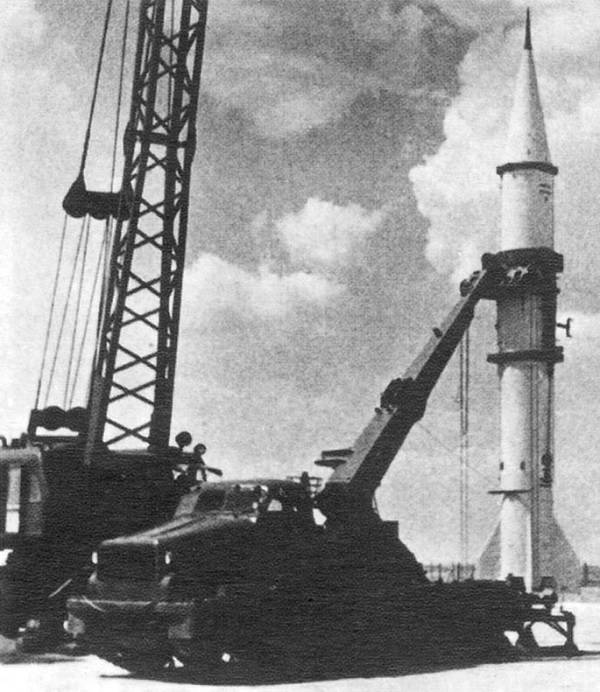
Tracked installer puts the P-11 rocket on the launch pad at the Kapustin Yar launch site. Photos from the site http://www.energia.ru
From the very beginning, the P-11 occupied a special place in the series of the Soviet missiles of the first “shooting” period. And not only because it was a fundamentally different scheme: it was prepared for a fundamentally different fate. Here is how Boris Chertok writes about this: “In 1953, the development of rockets on high-boiling components: nitric acid and kerosene began at SRI-88. The chief designer of the engines of these rockets is Isaev. Two types of missiles on high-boiling components were adopted: the Р-11 and Р-11М.
The P-11 had a range of 270 km with a starting mass of just 5,4 t, equipment was a common explosive with a mass of 535 kg. The P-11 was put into service in the 1955 year.
The P-11M was already the second nuclear rocket in our history (the first was the P-5. - Auth.). According to modern terminology, this is a tactical nuclear missile. Unlike all the previous ones, the P-11M rocket was located on a mobile self-propelled crawler mounted unit. Due to the more advanced autonomous control system, the rocket had the accuracy of hitting the square 8 x 8 km. It was put into service in 1956 year.
The last combat missile of this historical period was the first missile for the P-11FM submarine, similar in its basic characteristics to the P-11, but with a significantly modified control system and adapted for launching from the submarine mine.
So, from 1948 to 1956, seven rocket complexes were created and put into service, including for the first time two nuclear and one naval systems. ” Of these, one nuclear and sea were created on the basis of the same missile - P-11.
Story history P-11
The start of research work on the H-2, which ended with the creation of the P-11 rocket, was set by the Decree of the Council of Ministers of the USSR 4 of December 1950 No. 4811-2092 “On the plan of pilot work on ground-based weapons for the IV quarter of 1950 and 1951 ". The task of the designers from the royal OKB-1 was to create a single-stage rocket on high-boiling fuel components with the ability to store in the filled state for up to one month. Such requirements, provided that they were accurately fulfilled by the designers, made it possible to obtain at the exit a rocket perfectly suitable for a mobile missile system, which would be a weighty argument in the onset of the cold war.
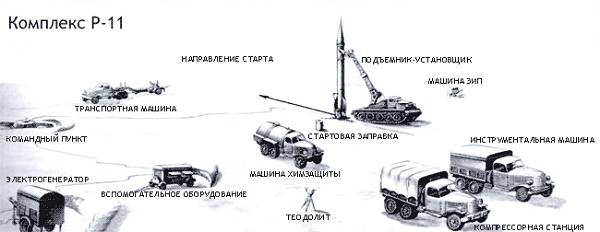
Starting battery of P-11 missiles on the position (diagram). Photos from http://militaryrussia.ru
The first leading designer of the future Р-11 was one of the most famous and unusual designers in the already extraordinary personalities of Sergei Sergeyev’s design office - Evgeny Sinilshchikov. It was to him that the Soviet tankers, although they hardly knew that name, were grateful for the appearance of a new, more powerful 85-millimeter weapon with the legendary "Tirid-Twenty", which allowed them to fight almost equal with the German "Tigers". A graduate of the Leningrad Voenmekh, the creator of the first large-scale Soviet self-propelled artillery system - SU-122, the man who re-armed the T-34, Yevgeny Sinilshchikov in 1945 was in Germany as part of a group of Soviet engineers who collected all the valuable German technical trophies. As a result, having become one of the participants in the first Soviet launch of the German V-2 18 in October 1947, in 1950, he already became Sergey Korolev's deputy in OKB-1. And it is quite logical that the “non-core” rocket on high-boiling components was transferred exactly to its jurisdiction: Sinilshchikov had an impressively broad engineering horizon to cope with this task.
Work went quickly enough. By November 30 1951 of the year, that is, less than a year later, a preliminary draft of the future P-11 was prepared. It clearly enough traced - as in all the OKB-1 missiles of that very early period - the influence of the V-2, as well as the half-reduced copy of the Vasserfal anti-aircraft missile. The developers remembered this rocket because it, like the future P-11, flew on high-boiling components, and for the same reason: the anti-aircraft missiles required the possibility of being in a filled state for quite a long time. The essential difference was in what components of the fuel were used in these missiles. In the German oxidizer, “Zalbay” served, that is, buodymic nitric acid (a mixture of nitric acid, diazot tetraoxide and water), and “Vizol”, that is, isobutylvinyl ether, served as fuel. In domestic development, it was decided to use kerosene T-1 as the main fuel, and as an oxidizer - nitric acid AK-20I, which is a mixture of one part of nitrogen tetroxide and four parts of nitric acid. TG-02 "Tonka-250" was used as a starting fuel, that is, a mixture of xylidine and triethylamine in equal proportions.
A year and a half went to the way from the conceptual design to the approval of the tactical and technical tasks of the customer - the military. 13 February 1953 of the Year The Council of Ministers of the USSR adopted a decree according to which the development of the P-11 rocket began and at the same time preparations for its mass production at the 66 plant in Zlatoust, where the Special Design Bureau for Long-Range Missiles, SKB-, operated from 1947. 385. And by the beginning of April, the first copies of the missiles were ready to take part in test launches at the Kapustin Yar test site, where at that time all the missiles and missile systems of the Soviet Union were tested. The experimental launches of the P-11 came out already under the guidance of a new lead designer. Just a couple of weeks before, he was one of the closest students of Sergei Korolev - Victor Makeev, the future doctor of technical sciences and academician, a man with whose name the entire history of the strategic submarine missile carriers of the Soviet fleet is inextricably linked. And she contacted at this very moment ...
How to teach rocket flying in two years
The first experimental launch of the P-11 rocket at the Kapustin Yar State Missile Range took place on 18 on April 1953 of the year - and was unsuccessful. More precisely, emergency: due to a manufacturing defect in the onboard control system, the rocket did not fly away from the launch pad, considerably frightening everyone who watched the launch. Among them was Boris Chertok, who describes his feelings from this start this way:
“In April, in the blooming and fragrant spring aromas of the Trans-Volga steppes in April at the Kapustin Yar range, flight tests of the first phase of the P-1953 began. At the first tests of a tactical missile on high-boiling components, Nedelin flew in (Mitrofan Nedelin, at that time an artillery marshal, commander of the artillery of the Soviet Army. - Approx. Aut.) And with him a retinue of high military ranks.
Starts were made from the launch pad, which was installed directly on the ground. Two kilometers away from the start, in the direction opposite to the flight, two vans with the receiving equipment of the Don telemetry system were installed near the LPI house. This observation point was loudly called IP-1 - the first measuring. All the cars, which were visited by the guests and the technical management, gathered for him. Just in case, Voznyuk, head of the landfill, ordered to open several shelter slots in front of the site.
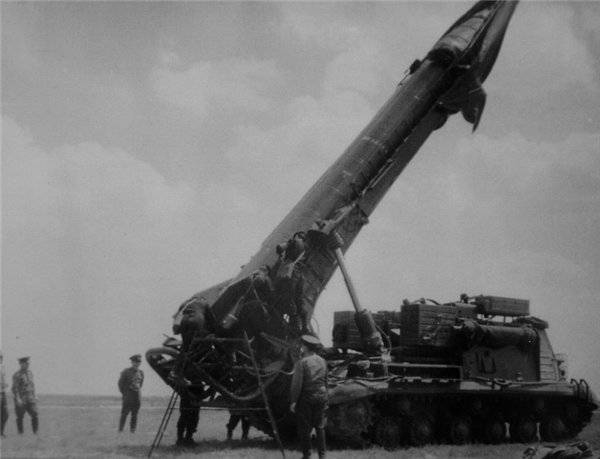
Combat training calculation self-propelled launcher serial missiles R-11M. Photos from http://military.tomsk.ru
My responsibilities at the P-11 launches no longer included bunker communication and the collection of readiness reports using field phones. After the end of the pre-start tests, I gladly settled on IPE in anticipation of the upcoming spectacle. It never occurred to anyone that a rocket could fly not only along the track ahead towards the target, but also in the opposite direction. Therefore, the cracks were empty, everyone preferred to enjoy the sunny day on the surface of the not yet burnt steppe.
At precisely the right time, the rocket took off, splashing out a reddish cloud, and, leaning on a bright fiery torch, rushed vertically upward. But after four seconds changed her mind, she did a type maneuver aviation "Barrels" and went on a dive flight, it seemed, exactly to our fearless company. Standing at full height, Nedelin shouted loudly: "Lie down!" Around him, everyone fell. I found it humiliating for myself to go to bed in front of such a small rocket (there are only 5 tons in it), and I bounced behind the house. I took refuge in time: there was an explosion. Lumps of earth pounded the house and cars. Here I was really scared: what about those who are lying without any shelter, and besides, now a red cloud of nitrogen can cover everyone. But there were no victims. They got up from the ground, crawled out from under the cars, shook themselves off and looked in surprise at the poisonous cloud carried away by the wind towards the start. The missile did not reach people only 30 meters away. The analysis of the telemetry records did not allow us to unambiguously determine the cause of the accident, and it was explained by the failure of the stabilization machine. ”
The first stage of the experimental launches of the P-11 was short-lived: from April to June of the 1953 year. During this time, they managed to launch 10 rockets, and only two launches - the first and the last but one - were unsuccessful, and both for technical reasons. In addition, during the experimental series of launches, it turned out, as Academician Chertok writes, that the engine thrust was designed by Alexey Isaev (engine designer who designed many engines for marine ballistic missiles, anti-aircraft missiles, ship brakes for space rockets, etc.) turned out to be insufficient - it was necessary to refine the engines. It was they who at the first stage did not allow the “eleventh” to reach the desired range, sometimes reducing it to thirty to forty kilometers.
The second stage of testing began in April of 1954 and took less than a month: before 13 May, 10 had time to execute start-ups, of which only one turned out to be emergency, and also due to rocket-builders: the automatic stabilization device failed. In this form, the missile could already be displayed on sighting and test tests, the first of which came from 31 December 1954 of the year to 21 of January 1955, and the second began a week later and lasted until February of 22. And again the rocket confirmed its high reliability: only one of the launches of this program from 15 turned out to be emergency. So it comes as no surprise that the 13 of July 1955 of the year the P-11 rocket as part of a mobile missile complex was adopted by the Soviet Army.
Продолжение следует ...
Information